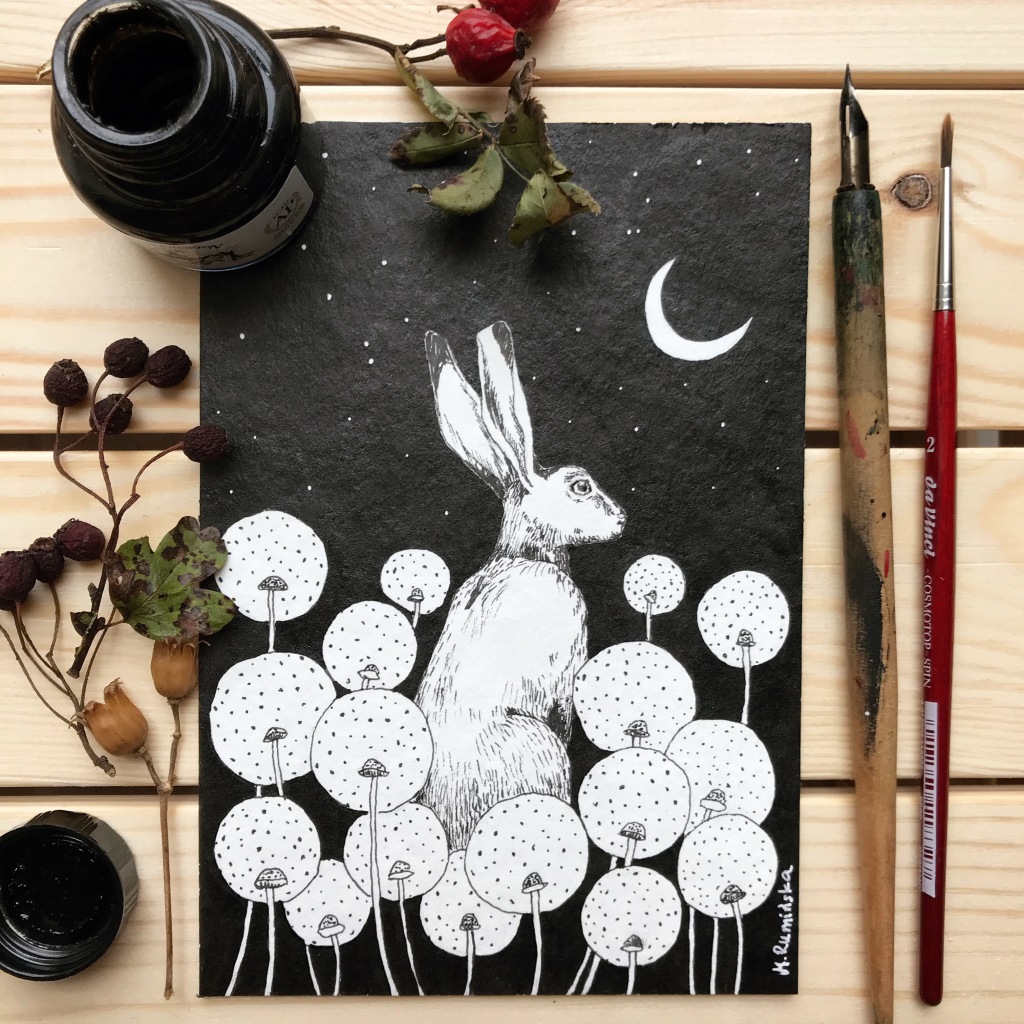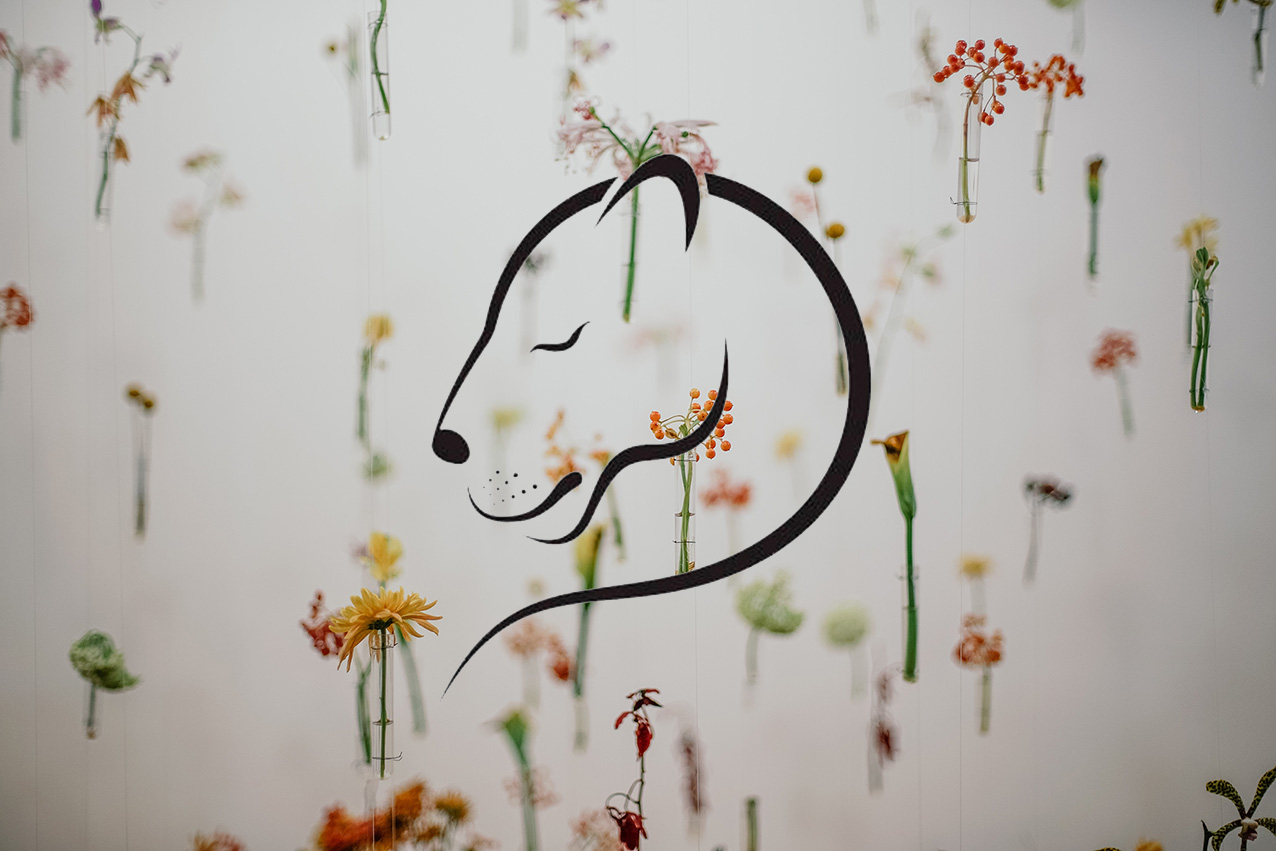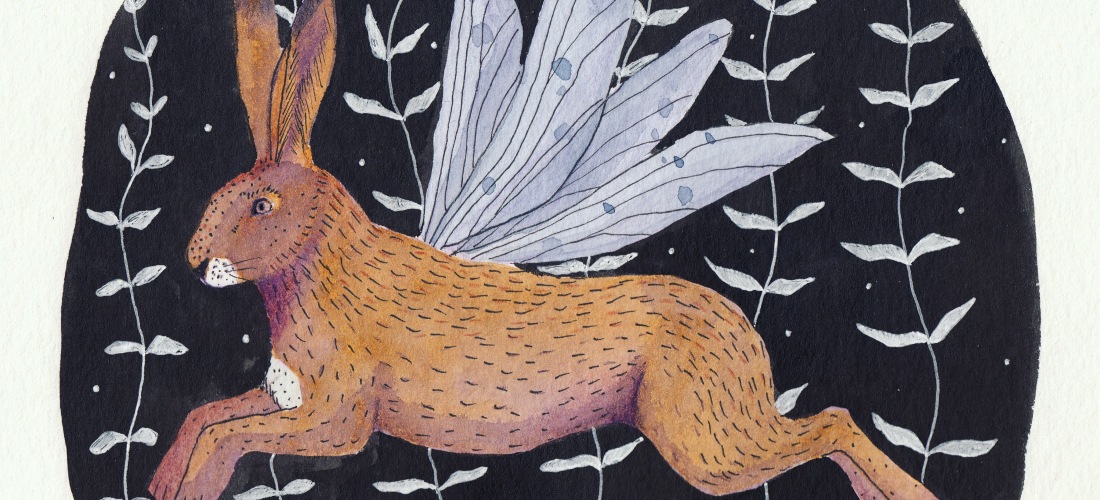Rabbits and hares belong to the leporidae family of mammals which contains over 60 different species varieties. Identifiable by their elongated furry ears, large eyes, long hind legs and short forelegs, they are a sight to behold when seen hopping amongst forests, grasslands and meadows. In this feature which is accompanied by artist Monika Ruminska Akwarele’s stunning watercolour illustrations, Sam Young leaps into some of the stories associated with these remarkable creatures synonymous with springtime, revealing their stratospheric links to the moon, goddess and witchcraft connections and roles as tricksters in folkloric beliefs from around the world.
Symbols of the Stratosphere
Around the globe, hares and rabbits appear hold esteemed positions in the stratosphere. First off, there’s the constellation Lepus (Latin for hare) which is said to depict a hare being pursued by the Greek hunter Orion and his pack of hunting dogs. Then there’s the fact that numerous symbolic connections have been made between hares, rabbits and the moon since the dawning of human civilisation. In Pagan beliefs spotting a moon-gazing hare is considered a sign of impending good fortune whilst in Canada, the Cree First Nation’s tribe tell a legend about an adventurous young rabbit who sought the help of a crane in order to fulfil his dreamt of riding upon the moon. Successful in his endeavour after much perseverance, it is said that if you cast your gaze upwards on the clearest of nights, you may still be able to spot him riding along on its crest. Though in Egyptian mythology the hare was viewed as gender fluid, androgynously leaping between genders in correspondence with the waxing and waning of the moon, far more legends associate hares with women – a detail which is believed to be the result of synchronicities between the 28 day duration of women’s menstrual cycle, a rabbits’ gestation period and length of a lunar moon. As a result much moon folklore has arisen which links hares to fertility, including the Chinese belief that female hares conceive by bathing in the glow of a full moon or lapping at moonlight from the fur of their male counterparts.

The Moon Rabbit
Fascinatingly, a large number of legends which connect hares with the moon appear to have emerged as a result of lunar pareidolia, or the act of perceiving images amongst the patterns found on the moon’s surface. Whilst many Westerners typically claim to see a man in the moon, in many more countries around the world, including China, Japan and Mexico, it is believed that a specific area of the moon’s dark patches actually resemble a rabbit. Across Asia, moon-viewing festivals take place annually during autumn in honour of the moon and the Moon Rabbit or Jade Rabbit who is said to dwell there. Typically depicted pounding a pestle and mortar whose contents range from the elixir of immortality to the more humble rice or moon cakes and Japanese mochi (depending on the region or country it is told), legend states that the rabbit came to be etched on the moon’s surface as a result of it demonstrating great virtue and sacrificing itself on the behalf of humans. Told in the anthropomorphic tradition then, the rabbit appears to act as an animal stand-in for human morality. Although the story is believed to have originated in China it has spread across Asia and many alterative versions of this fable can also be found, including Tale 316 from the Indian Jakata Tales, which sees the hare become one of Buddha’s nonhuman incarnations. On the other side of the planet, remarkably similar tales also exist in the folklore of indigenous American cultures of Mesoamerica which likewise purport to rabbits being used or offering themselves up as sacrifices in creation stories of the sun and the moon.
Goddess Companions
Rabbits and hares also appear to have long been the companions of goddesses including some associated with some of the aforementioned lunar legends such as the Mayan moon goddess, Po, who is frequently depicted holding a rabbit and seated next to the waxing moon, and the Chinese lunar deity Chang’e, who resides over the moon as a result of stealing the elixir of immortality from her husband. During Anglo-Saxon times, hares were believed to have served as messengers to the goddess of spring and the dawn, Eostre, who also assumed the form of a human-sized hare on the night of a full moon. In Celtic mythology, hares were sacred creatures due to the fact that they were believed to have direct access to the Otherworld. It was therefore considered sacrilege to consume their meat. Later, with the rise of Christianity, certain elements of these pagan myths would get re-appropriated by Christians. The goddess’ name Eostre would be transformed into Easter, the name of the Christian celebration of the resurrection of Christ and the earlier pagan belief that during the vernal equinox rabbits would deliver eggs would evolve into the modern day tradition which sees the Easter Bunny deliver chocolate eggs to children on Easter Sunday.

Witchcraft Associations
Prior to leading the revolt against the Romans in 60 CE, warrior queen Boudicca is said to have performed a divination involving a hare which was believed to foretell their impending victory when it ran to the side of the Brits as she released it from the folds of her cloak. However, once the Christian faith spread across the Western world, many of the earlier positive connections made between women and hares began to fall out of favour instead becoming lnegatively linked to witchcraft. Nowadays we most often assume the black cat to be the witch’s most faithful companion, yet in actual fact, rabbit and hares were once believed to be the preferred familiars of European witches, supposedly assisting them in their magical spells. Due to these associations, to this day across the British Isles it is still widely considered bad luck should a hare cross your path (much like the black cat) and there is a wealth of folklore and superstition which makes the hare and the witch allies in the dark arts.
During the 16th century as the witch-hunt craze took hold of Britain so too did the belief that women had to power to metamorphose into hares. Scottish and Irish folklore is especially abundant with tales of shapeshifting witches taking the form of hares such as “The Beekeeper and the Bewitched Hare” which can be found in the 1962 collection, Thistle & Thyme: Tales & Legends from Scotland by Sorche Nic Leodhas. Many more tales purport to witches assuming this animal’s form in order to steal milk or butter from members of local communities, returning to human form if caught. These include “The Witch Hare,” which was collected by WB Yeats in Fairy and Folk Tales of the Irish Peasantry in 1888. The Irish butter stealing hag hare motif has since been revised by playwright, author and folklorist Eilis Ni Dhuibhne in the play, Dún na mBan trí Thine (The Women’s Fort is on Fire) which according to Sarah O’Connor uses the nonhuman identity of the hare to enable women “to challenge social boundaries and traditional hierarchies.”

In Ireland, it was widely believed that witches and hares were so attuned to each other that if a hare was somehow injured a witch in that community would also display the same injury. According to Patricia Monaghan, shooting a hare with a silver bullet was considered the best way to reveal the witches true form, much like the method adopted for ousting men disguised as werewolves in European folklore.
Links between hares and acts of witchcraft have also made their way into the history books, including rumours which suggested Anne Boleyn, the second wife of Henry VIII was a witch. A voiceless victim of patriarchy who was beheaded for her supposed adultery and inability to bore the king a prized male heir, she is now said to take the form of a hare when she haunts her parish church. Isobel Gowdie, who is often regarded as Scotland’s most famous ‘witch,’ after voluntarily confessing to acts of witchcraft in 1662 personally believed that she was granted the power to transform into a hare by the Devil himself in order to do his bidding. On one occasion, Gowdie described being chased by a pack of hounds whilst assuming her non-human form, uttering this disenchanting charm in order to save herself:
Hare, hare, God send thee care!
I am in a hare’s likeness now;
But I shall be a woman even now-
— Hare, hare, God send thee care!
Tales of Trickery
Acts of trickery and deception are frequently associated with hares and rabbits in folklore around the globe, including the story of the Irish Fairy Rabbit. When travelling to and from Tory, and island off the north-west coast of Ireland, sea voyagers would superstitiously carry earth collected from their homes in their pockets in order to protect them from this malevolent being whom it was believed attempted to lure people into being drowned at sea. During the 18th century, an English woman named Mary Toft managed to fool doctors into believing she had given birth to a bury of rabbits which the woman believed was brought on by the earlier trauma of being startled by one. Clearly a victim of ‘maternal impression,’ a now discounted medical theory in which it was thought that emotional stimuli could be transmitted to the unborn foetus and cause birth defects, Toft eventually admitted to manually inserting the dead rabbits and feigning their birth. Let down by the State rather than giving her the psychological treatment she so obviously neeed, she was later charged with fraud and incarcerated. Toft’s story is retold by Irish author Emma Donoghue’s short story collection, The Woman Who Gave Birth to Rabbits (2002) which also documents other peculiar happenings which have taken place in the history of the British Isles.
Yet perhaps the most subversive hare to emerge is the one which has been the subject of many African folk tales who is depicted as a notorious trickster who uses his intellect to outwit others. Tales of trickster hares spread across America as a result of being transmitted by West African slaves. These earlier tales are believed to have heavily influenced the stories surrounding the popular African American folkloric figure, Br’er Rabbit. Believed to represent enslaved Africans exacting their revenge on white oppressors and overcoming adversity, this trickster hare has consequently become a symbol for deconstructing oppressive hierarchies of subjugation. In 1982, Toni Morrison uses the one of the most well-known Br’er Rabbit tales, about a tar baby for the inspiration for her novel, Tar Baby. In Writing Tricksters, Jeanne Rosier Smith describes Morrison as using the tale to develop an “array of trickster characters, whose conflicting attitudes toward community allow her to simultaneously affirm the importance of culture building and challenge prescribed gender roles within African American communities.”
Sam Young is editor and founder of Lyonesse. Monika Ruminska Akwarele is a self-taught artist, born in 1988, in Warsaw, Poland who has always loved painting and creating art. She cites animals and nature as her greatest inspiration and gets a lot of creative energy from watching the seasons changing. Painting mostly with watercolours, which are her favourite medium she also sometimes uses ink and gouache paints. You can view more of her beautiful nature inspired art over on her Instagram page @eszillui
Recommended Reading
Donoghue, Emma. The Woman Who Gave Birth to Rabbits, London: Virago, 2002.
Morrison, Toni. Tar Baby. New York: Knopf, 1981.
Nich Leodhas, Sorche, “The Beekeeper and the Bewitched Hare,” Thistle & Thyme: Tales & Legends from Scotland, 1962.
Jeanne Rosier Smith, Tracey. Writing Tricksters: Mythic Gambols in American Ethnic Literature, Los Angeles:University of California Press, 1997.
Yeats, W.B. “The Witch Hare,” Fairy and Folk Tales of the Irish Peasantry, London: Walter Scott, 1888.
Kirkpatrick, Kathryn, Faragó Borbála et al, Animals in Irish Literature and Culture, London: Palgrave, 2015.

